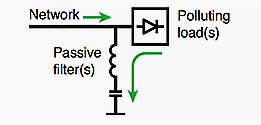The influence of harmonics
There are three possible ways of suppressing or at least reducing the influence of harmonics. The fourth way is a special case.

Contents:
- Reducing generated harmonic currents
- Modifying the installation
- Filtering
- Special case – circuit breakers
1. Reducing generated harmonic currents
Generated harmonic currents can be reduced by:
1.1 Line choke
A 3-phase choke is connected in series with the power supply (or integrated into the DC bus for frequency inverters). It reduces the line current harmonics (especially high number harmonics) and therefore the rms value of the current consumption and the distortion at the inverter connection point.
It is possible to install the choke without affecting the harmonics generator and to use chokes for several drives.


1.2 Using 12-phase rectifiers
Here, by combining currents, low-order harmonics such as 5 and 7 are eliminated upstream (these often cause the most disturbance owing to their large amplitude). This solution requires a transformer with two secondary windings (star and delta), and only generates harmonics numbered 12 k ± 1.
1.3 Sinewave input current devices
This method consists in using static converters where the rectifier uses PWM switching to absorb a sinusoidal current.
2. Modifying the installation
Modifying the installation can be performed by immunising sensitive loads with filters, increasing the short-circuit power of the installation, derating equipment or to:
2.1 Segregate polluting loads
As a first step, the sensitive equipment must be connected as close as possible to the power supply source.
2.2 Modify protective devices and oversize the capacitors
The choice of solution depends on the installation characteristics. A simple rule is used to choose the type of equipment where Gh is the apparent power of all generators of harmonics supplied from the same busbar system as the capacitors, and Sn is the apparent power of the upstream transformer(s):
- If Gh/Sn ≤ 15%, standard equipment is suitable
- If Gh/Sn > 15%, there are two possible solutions.
For polluted networks (15% < Gh/Sn ≤ 25%):
The current rating of the switchgear and in-series links must be oversized, as must the voltage rating of the capacitors.
For very polluted networks (25% < Gh/Sn ≤ 60%):
Anti-harmonic chokes must be connected to the capacitors and set to a frequency lower than the frequency of the lowest harmonic (for example, 215 Hz for a 50 Hz network). See figure 1 below. This eliminates any risk of resonance and helps to reduce harmonics.


3. Filtering (passive, active and hybrid)
Where Gh/Sn > 60%, specialists must calculate and install the harmonics filter (see Figure 2 below – Principles and characteristics of passive, active, and hybrid filtering).
| Filter | Principle | Characteristics |
| Passive | By-pass series LC circuit tuned to each harmonic frequency to be eliminated.
|
|
| Active | Generation of current cancelling out all harmonics created by the load.
|
|
| Hybrid |   | Offers the advantages of passive and active filtering solutions and covers a wide range of power and performance:
|
3.1 Passive filtering
This involves connecting a low impedance by-pass to the frequencies to be attenuated using passive components (inductor, capacitor, resistor). Several passive filters connected in parallel may be necessary to eliminate several components.
Careful attention must be paid to the sizing of harmonic filters: a poorly designed passive filter may lead to resonance and amplify frequencies which did not cause disturbance before installation of the filter.


3.2 Active filtering
This consists in neutralising the harmonics induced by the load. First an analysis of the current identifies them in amplitude and phase. Then the same but opposite harmonics are produced by the active filter. It is possible to connect several active filters in parallel.
An active filter may for example be connected to a UPS to reduce harmonics which have been injected upstream.


3.3 Hybrid filtering
This consists of an active filter and a passive filter set to the order of the dominant harmonic (e.g. 5) which supplies the necessary reactive power.
4. Special case – Circuit breakers
Harmonics may cause unwanted tripping of protective devices. Care must be taken when choosing protective devices to avoid this.
Circuit breakers can be fitted with two types of trip device, thermal-magnetic or electronic.
The heat sensors of thermal-magnetic circuit breakers are particularly sensitive to harmonics and can identify the actual load on the conductors caused by the presence of harmonics. They are thus well suited to use on low current circuits, essentially in domestic or industrial applications.
These devices have the advantage of being better able to track changes in the temperature of cables, particularly in the case of cyclical loads, as their thermal memory is superior to that of indirectly heated bimetallic strips.
Harmonics for beginners (VIDEO)
This eLearning Module provides a basic understanding of electrical harmonics, with an explanation of how they are created and how they can be eliminated from the electrical grid.
Reference // Cahier Technique Schneider Electric no. 199 – Power Quality by Philippe FERRACCI













Good example . Problems with harmonics is a common of today problems.
I really like the harmonics problem article
really nice article
Edvard you are truly heaven sent. Thank you for your unselfish support to the Electrical Engineering profession. May your tribe increase.
I`m impressed of the activity and the expertise of Eng. Csanyi and his readiness to share his wide experience. Good for him!